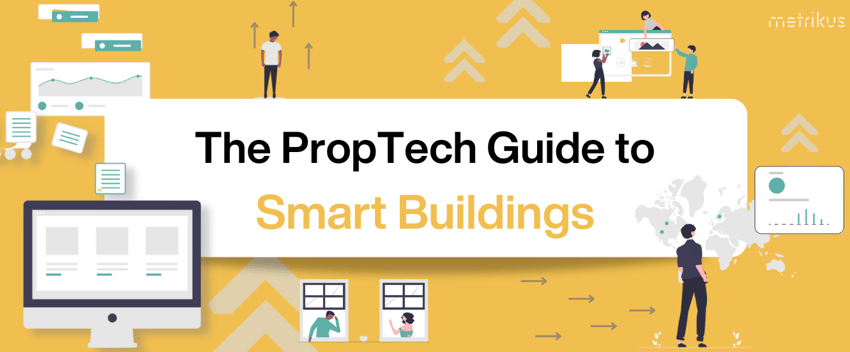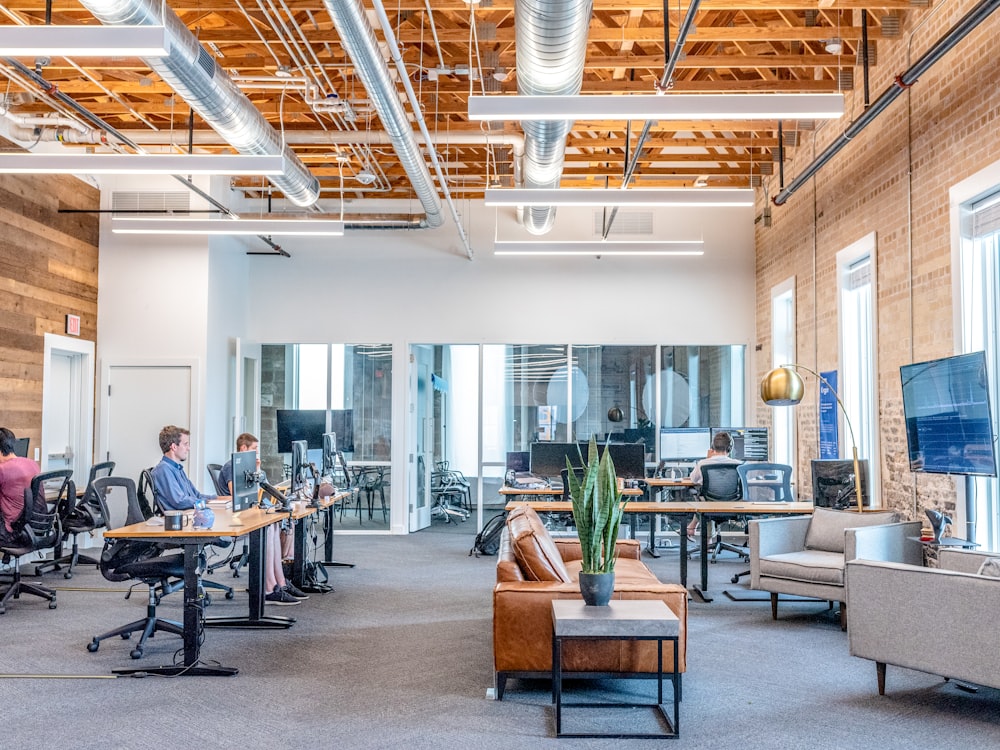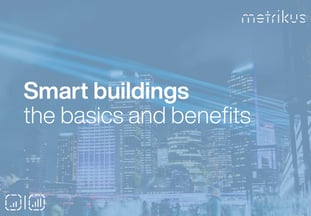The ultimate guide to smart buildings | Features & benefits
It’s time to dive into a topic very dear to our hearts – one that we discuss day in, day out: smart buildings.
Read on to find out more about the history of smart buildings, how they can add value to your organization, and where we expect the industry to head in the future.
Contents
- What is a smart building?
- What tech do smart buildings use?
- Privacy in smart buildings
- Space utilization
- Wellbeing and occupant safety
- Environmental impact
- Bloomberg European Headquarters
- Uniqa Tower
- The Edge
- SalesForce Tower
- The Westin Houston Medical Center
The past and the future of smart buildings
Smart buildings 101
What is a smart building?
The term ‘smart building’ describes any structure that automates and controls building systems – such as heating, lighting, ventilation and air conditioning – using smart processes.
With the help of Internet of Things (IoT) sensors, data about the built environment is collected and managed to improve the function of an existing building management system (BMS).
If you work in facilities or building management, you’ll know how costly keeping a building running can be – especially a large office space or factory.
Things like lights being on in empty rooms or heating being blasted in a room with open windows can have a huge environmental and financial cost.
A smart building aims to avoid wastage, creating a space that’s more efficient, sustainable, and promotes occupant wellbeing.
Analyzing data collected from different sensors means facility managers can understand more about their space and track asset performance, reduce energy usage, and optimize space utilization.
And don’t just take our word for it, smart buildings drive average energy savings of between 15% and 25%.
Features of a smart building
So, what are the features that differentiate smart buildings from bog-standard ones?
Smart buildings, by nature, use tech to drive environmental, social and financial benefits to building owners and occupants. In practice, most smart buildings will have:
- A connected building management system (BMS) to control aspects such as heating and lighting
- Sensors to monitor key factors like indoor air quality, occupancy and energy
- A platform to access and visualize all this data
These are the fundamentals, but other great smart building features connect people with technology in a useful way – think automatic doors, voice control and facial recognition.
What tech do smart buildings use?
Smart buildings employ a range of solutions, many of which have internet connectivity, also known as Internet of Things (IoT) technology.
This means that sensors or devices can record, receive and send data across different aspects of the building. Data is usually monitored from a centralized hub and stored in the cloud.
Privacy in smart buildings
A common worry with smart buildings is that they could infringe on occupancy privacy, or that all this key data could fall into the wrong hands and be misused.
And it’s certainly an understandable concern, how can buildings possibly capture so much information about us without having every single move we make on record – and how is all this data kept secure?
The answer is far less sinister or futuristic than we might think, as the majority of smart building tech doesn’t capture any identifiable information about occupants.
For example, an occupancy sensor would count ‘one person at desk X’, rather than ‘Joe Bloggs is at desk 12’. It’s best to opt for smart building tech that explicitly states it doesn’t rely on the use of cameras, so employees never have to worry about being filmed while they work.
Any smart building equipment that uses invasive technology (such as CCTV or WiFi tracking) will capture some personal information, but this data is usually transmitted anonymously after it’s been automatically processed.
Like anything that relies on the cloud, this data is at risk of being accessed by third parties, especially if there are security flaws present.
That’s why we always advise choosing a provider that lets you own your data, rather than it being owned by someone else. That way you can keep it right where you want it, and ensure it’s being stored safely.
How to make a building smart
First thing’s first, any building can be smart, regardless of age, size or layout.
Most people think smart buildings have to be extremely modern, cost the earth, or involve invasive installation. This isn’t the case – the fundamentals of creating a great smart building are identifying your priorities (you might want a space that’s as safe as possible, or maybe you’re more concerned about hitting certain energy targets), and having access to accurate data.
So, where do you begin?
There’s a term you may have come across in the PropTech world: retrofitting. But what exactly is retrofitting?
To put it simply, retrofitting refers to renovating, refurbishing, or fitting existing buildings to upgrade them to hit modern building standards.
This often involves modifications to make a building more sustainable or healthy for its occupants, through improving HVAC systems, updating lighting systems, and installing an IoT network.
For anyone starting out on the journey of creating a smart building, we’d always recommend you start with the essentials to really ensure you’re getting the most out of your built space, and creating an environment that drives actual results for you.
- Install occupancy and capacity sensors
- Install indoor air quality sensors
- Add cloud integration to your building management system
- Start using employee apps to automate desk booking and other actions
- Implement smart maintenance and smart cleaning
Starting from scratch can be quite a daunting and time-consuming task, but technical advancements in recent years mean the process is more accessible than ever.
Due to increasing demand, companies are becoming more innovative with offering friction-free solutions. For example, (shameless plug incoming) we developed The Smart Building Starter Kit in 2021 to remove some of the barriers commonly associated with creating a smart building, such as cost and time.
-1.png?width=650&name=Project%20Tiber%20box%20no%20background%20(1)-1.png)
- Keen to turn your office into a smart one? Read our blog post: what does a smart office actually look like?
Benefits of smart buildings
Creating a smart building brings an entire host of benefits to all key stakeholders, from the building owner to the people working within it.
Benefits include:
- Reduce costs: According to New York Energy Research, adopting smart technology can reduce costs by an average of 15%
- Increase employee productivity: Smart buildings can create a more comfortable environment for employees, resulting in increased productivity
- Minimize energy consumption: According to a recent report by Transforma Insights, by 2023, IoT adoption is expected to save eight times the energy it consumes. Results show that it could save up to ‘230 billion cubic metres of water and eliminate one gigaton of CO2 emissions’. By automating the HVAC system and lighting alone, a smart building can save 23% of energy that is used. Through additional automations and tracking, it can save up to 50%
- Improve the health and well-being of tenants/employees: Tenants' wellbeing should be at the top of the priority list for landlords. Smart buildings result in strong returns and satisfied tenants. In workplaces on the other hand, controlled lighting, temperature, room layout, and indoor air quality, amongst other things can all play a part in optimizing employees wellbeing
- Maximise utilization of your entire space: At Metrikus, we can show you how many people are in certain areas making occupancy and capacity management easier than ever
- Immediately identify and fix faulty equipment: Through the use of IoT sensors, warnings can alert when there is a reduction in performance or any issues with machinery. This prevents faulty equipment as problems can be identified and fixed before machinery malfunctions
- Enhance decision-making through real-time, accurate data: Smart sensors collect real-time data and even have decision-making functions, optimizing business operations and performance
Although all of these benefits are obviously great in any building, we’ve picked out the ones that we think yield the greatest results to explore in more detail.
Photo by Austin Distel on Unsplash
Space utilization
When it comes to budgets, renting physical office space is one of the biggest financial outgoings for businesses – especially in costly cities like London or New York.
So you can understand why building owners may want to reduce this space where possible, particularly if a large portion of the space isn’t even being used.
Smart buildings help maximize space utilization in a number of different ways, starting off with having access to real-time, accurate data. Finding out how a building is actually being used is the first step in running it as effectively and efficiently as possible.
This involves installing sensors to monitor different data points – such as occupancy or capacity – and gain a comprehensive view of how often, and when, different areas are being used.
Once this data is collected and continues to be monitored, it can be used to inform decisions about downsizing, reallocating space, or creating a more effective hybrid work strategy.
Communicating this data to employees and occupants can also help reduce time wasted due to finding a suitable meeting space or desk. We’ve all been there: wandering around trying to find a free conference room, and suddenly half your allocated time has been used up.
Many smart building platforms now display real-time occupancy data on an app or screen in the office, which can inform employees at a glance whether an area is available or not.
Beyond this, analysis can be done to see if the space is configured in a way which actually suits occupant needs. For example, if a large boardroom is consistently being used for two- or three-person meetings, it could be worth rearranging the layout to include fewer large meeting spaces, and have more, smaller areas for private conversation.
Similarly, desk monitoring sensors have become increasingly popular in recent years. Where many companies have adopted hot-desking policies which bring about loads of benefits, no one wants to start their day by searching for a seat for ages.
Desk booking systems with integrated monitors mean employees can book their seat ahead of time, and the desk is made available if they don’t end up using it. This is a great way of implementing flexible working while maintaining oversight of how much your space is actually being used.
- Learn more about how to improve your space utilization with occupancy monitoring
Wellbeing and occupant safety
- Keeping spaces safe
Occupancy, capacity and indoor air quality monitoring all drive notable improvement to tenant wellbeing and safety, especially in light of the COVID-19 pandemic.
The role of smart building tech played a big part in addressing hygiene and social distancing concerns when employees were first being encouraged back into their offices. For instance, occupancy monitors can alert when people are sitting too closely, whereas capacity sensors provide real-time updates about whether the maximum number of people in a space has been exceeded.
It’s worth noting that this benefit extends far beyond the standard office – many gyms now provide members with accurate, up-to-date information about how busy the space is so they can choose when to visit.
- Keeping spaces healthy
If there’s one thing COVID-19 brought into the mainstream, it’s air quality. As soon as scientists discovered the virus is airborne, the need for healthier indoor air became crucial.
This really put the onus on employers to create a healthy environment for their employees, but also to communicate this in a way that was clear and effective. Otherwise, people simply wouldn’t be returning to work.
In buildings like hospitals, the need for clean air was (and still is) even more important, and smart solutions can really enable this.
By installing indoor air quality (IAQ) monitors in any building, the key air quality parameters – such as temperature, humidity, carbon dioxide, TVOCs and particulate matter – are constantly tracked to ensure the space is as safe and healthy as possible.
As well as reducing virus transmission, maintaining good IAQ maximizes productivity and minimizes sick building syndrome (SBS) symptoms: seems like a win-win to us!
- Keeping spaces clean
Just like air quality, the COVID-19 pandemic made us much more aware of the importance of hygiene and cleanliness.
Cleaning any large indoor space, whether it's an office, university library, bank, can be very difficult.
High-traffic areas, like restrooms, get dirty incredibly quickly, whereas other spaces may barely be touched in the same time period.
Cleaning needs to be done proactive to maintain a space that’s hygienic and enjoyable for everyone.
Through installing smart sensors, this information can be used to track cleaning frequencies and gain feedback to establish when cleaning is needed.
Cleaners can then press a button to record once an area is cleaned, creating a reliable source of information that can be accessed by anyone.
Some companies are even overlaying this cleaning data with live and historic occupancy levels. This means occupants will have a better understanding of how the space has been used: which areas have had loads of contact (think door handles) vs. areas that haven’t actually been touched since they were last cleaned.
With smart tech, cleaning becomes more focused, effective, and time-efficient.
Environmental impact
Buildings are responsible for around 40% of emissions generated across the world, so it’s vital that changes are made to ensure they’re as green as possible.
Commercial buildings use a huge amount of energy everyday – you don’t have to look far in built up areas before you stumble across a brightly lit office with only one or two people inside.

Smart buildings play a key role in reducing environmental impact across the real estate industry through minimizing carbon emissions and conserving energy more efficiently, resulting in cost-saving benefits for the building owner, as well as environmental benefits on a much wider scale.
Solutions like energy monitoring mean that building management functions – such as lighting, heaving, and air conditioning – can be monitored in real time, and this data can be recorded and stored in the cloud to allow for data analysis.
By monitoring these functions, companies can better understand how much energy they’re actually using, and quickly detect inefficiencies or faulty equipment that may be leaking energy. These issues can then be adjusted automatically through the smart platform, saving time and money on unnecessary maintenance call-outs.
Smart technology is also revolutionizing the aspects of buildings that we often don’t give a second thought to. For example, engineering company KONE has been using AI and IoT to transform elevators and escalators, making them faster and more comfortable – all while consuming 90% less electricity than traditional ones.
- If you want to learn more about improving building sustainability, this blog post dives into the difference between net zero and carbon neutral
Real-life smart buildings
The term ‘smart building’ often conjures up images of futuristic spaces with all the modcons – but this doesn’t have to be the case.
A building can be ‘smart’ without looking particularly fancy, and can span any industry – if it uses technology and improves the building’s operations, then it counts as smart.
We’ve picked some of the real-world examples that stood out to us.
Bloomberg European Headquarters, St. Paul’s, London
Bloomberg’s HQ is a great example of using smart tech to hit sustainability goals. With a BREEAM sustainability rating of 98.5%, the office takes a comprehensive approach to improving employee wellbeing while minimizing its environmental impact.
Sensors monitor occupancy movement throughout the building and adjust airflow in line with these levels, saving ‘600-750 MWh of power per year’. An on-site water treatment plant, recycled water system and vacuum-flush toilets massively reduce wasted water – the building is 70% more water-efficient than the average office.
The final energy-saving tactic is custom bronze blades fitted to the outside of the building, when the outside temperature is warm the blades come into action and the indoor HVAC system can be switched off.
Uniqa Tower, Vienna
The Uniqa Tower’s automated HVAC system responds to the outdoor temperature, which saves a huge amount of energy every day. Their annual CO2 emissions have reduced by a huge 84 tons.
The Edge, Amsterdam
The Edge was called ‘the smartest building in the world’ by Bloomberg in 2015, and for good reason. Home to one of Deloitte’s headquarters, it has a BREEAM sustainability score of 98.4%, is packed with 28,000 sensors, and even has an app where each employee can adjust their light and temperature preferences.
SalesForce Tower, San Francisco
Another building which makes great use of smart tech is the SalesForce Tower in San Francisco. It combines digital twins with a smart HVAC system and water recycling to reduce energy consumption, cut down water wastage and provide better understanding of space utilization.
The Westin Houston Medical Center, Texas
Maybe not as outwardly impressive as our other mentions, this Texan hotel is the first US hotel to adopt LightStrike Germ-Zapping Robots in their building. These new additions to their workforce aid in sanitizing and disinfecting guest rooms and common spaces to reduce COVID-19 transmission.
The history of smart buildings
It all started in the 40s…
The idea of smart buildings has been around for ages, and it can all be traced back to 1947 with the invention of the transistor. This sounded the gong for the start of the Digital Revolution, with the birth of the world’s first computer in 1951. Not long after, the first iteration of modern-day internet – ARPANET – entered the world in 1961, paving the way for IoT devices everywhere.
The sustainable 60s (and 70s)
Awareness of environmental issues gained traction during the late 60s, with sustainability disasters – such as the 1969 oil spill in Santa Barbara – shining a light on a need for greater environmental commitments. This led to the birth of Earth Day in 1970, which inspired the introduction of pioneering US legislation and the Green Building Movement began.
The 80s: synthpop and technological advancements
The 80s introduced us to some major tech, like the personal computer and the first mobile phone. No one knew it back then, but these would go on to become key elements of the modern smart building.
The first ever ‘intelligent buildings’ (coined by United Technology Building Systems) entered the world in 1981. At the time, these buildings controlled HVAC systems and boasted minimal energy consumption and improved efficiency. Although they lacked the internet connectivity that makes buildings ‘smart’ today, they laid the important groundwork for what was to come.
World Wide 1990
Perhaps the most important element of smart buildings – the internet – came onto the scene in the 90s. With the World Wide Web, internet connection was made public for the first time, completely revolutionizing how people interacted with the internet and opening new doors for work habits and communication. The development of tech boomed from here, and offices began to embrace this change and became open-plan, collaborative spaces.
Smart building millennium
Smart tech continued to grow in popularity throughout the 2000s (the iPhone has now been around for 15 years!) and the smart buildings movement was growing in its own exciting way. The term ‘smart buildings’ was coined, and over the next 20 years different building technologies were integrated into common use to bring about the social, environmental and financial benefits we’re familiar with today.
The future of smart buildings
As we continue to see PropTech being more widely adopted, there are still a few hurdles that prevent smart buildings from becoming the norm just yet. From security concerns to hesitations around cost, there’s no denying that businesses (in any and every industry) need a technology-first mindset to future-proof their buildings effectively.
Despite this, it’s not hard to see why the buzz around smart buildings continues, especially as they have benefits that really do impact occupants across the entire space:
- They can help minimize energy consumption and reach vital sustainability goals
- Occupant wellbeing and productivity is improved through indoor air quality monitoring and smart cleaning
- They provide the relevant personnel with data-rich information to help them make informed decisions about how to use their space more efficiently
Will the smart building industry continue to grow?
So, we’ve covered a lot about smart buildings: how they came into existence, their benefits, but where do we go from here?
The industry is booming. Recent research estimates that the number of smart buildings across the globe will rise from 45 million in 2022 to 115 million by 2026 – growth of over 150%.
In light of the COVID-19 pandemic and international sustainability regulations such as Local Law 97 and SECR, smart buildings are increasingly being expected to respond to real-world concerns. We think the trajectory of these trends will continue to rise, with smart building growth areas being:
- Enhancing occupant wellness even further through adopting more people-focused technologies
- Reducing buildings’ carbon footprint, and proving this through data
- Facilitating a successful hybrid culture as companies and employees become more flexible
- Smart buildings providers proving they can deliver higher returns as competition grows
- Greater focus on ease of integration and a friction-less process
The past few years have completely altered the role buildings play in our lives, and smart technology can help to create more sustainable, cost effective and healthy spaces.
The growing generation of smart buildings will deliver on individual concerns – such as productivity and costs – while minimizing harm to the environment. We’re certainly looking forward to playing a part in creating the smart buildings of the future.





